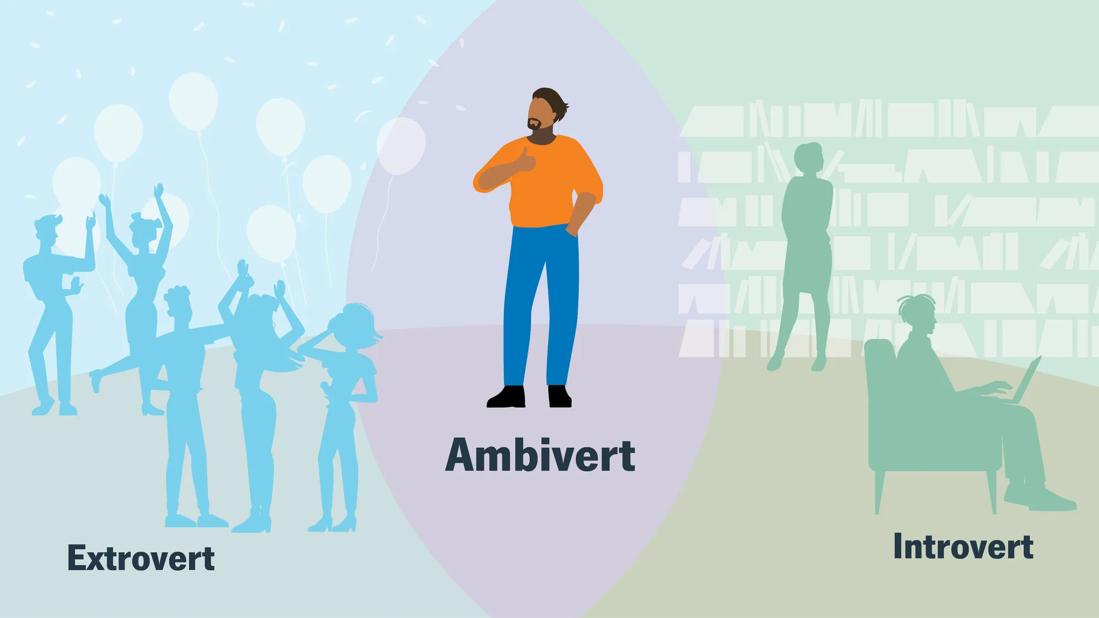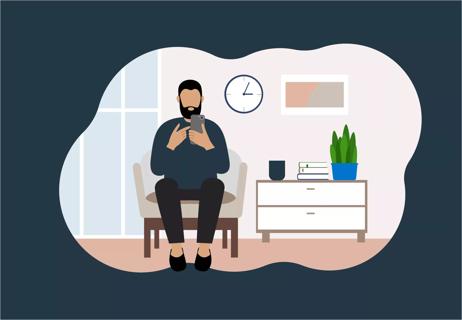Ambiverts tend to balance traits of both introverts and extroverts — and they’re more common

It can feel comforting at times to label things as one or the other. Right or wrong. Nature or nurture. Left brain or right brain.
Advertisement
Cleveland Clinic is a non-profit academic medical center. Advertising on our site helps support our mission. We do not endorse non-Cleveland Clinic products or services. Policy
But in real life, things aren’t always as simple as black and white.
And that’s true of personality types, too. So, while some people are classically introverted or extroverted, a lot of people fall into a happy medium.
They’re called ambiverts. And by some accounts, two-thirds of us are neither introverts nor extroverts, but somewhere in between.
“Research suggests that most people exhibit a mix of introverted and extroverted traits rather than extremes of either,” says psychologist Darrielle Allen, PhD. “But ambiverts are often overlooked because more extreme personalities tend to grab more attention. They often fly under the radar.”
Dr. Allen shares what it means to be an ambivert and traits common with this personality type.
Ambivert is a personality type that falls in the middle between introversion and extroversion.
Introverts are energized by being alone with their thoughts. Extroverts are fueled by spending time with other people.
Ambiverts can come to life in either situation. They can “turn it on” when called to. But they also know when to pull back for times of quiet introspection.
“An ambivert is someone who balances traits of both introversion and extroversion," Dr. Allen elaborates. “They’re flexible, adapting their behavior to the demands of the situation. They might thrive in a lively social setting but also enjoy quiet moments alone to recharge. Ambiverts are comfortable in both environments.”
Advertisement
In other words, ambiverts tend to go with the flow. They can feel as equally (or nearly equally) energized by meeting new people at a lively party as by quietly journaling their thoughts alone with a cup of tea.
Personality types live on a spectrum. Introverts and extroverts are on either side of the scale. Ambiverts are somewhere in the middle.
But that doesn’t mean that ambiverts are necessarily half introverted and half extroverted. Ambiverts can lean toward one side or the other, while still maintaining a balance of both.
“Ambiverts are not necessarily 50-50 introvert and extrovert all the time,” Dr. Allen clarifies. “Their tendencies can fluctuate depending on their mood, energy level or environment.”
There are two most commonly described types of ambiverts:
Ambiverts can be more difficult to pinpoint than introverts or extroverts. They’re flexible. So, if you meet them at a networking event, you may peg them for an extrovert. If they’re in your close-knit book club, you may assume they’re an introvert.
Dr. Allen walks us through a few traits that may signal you or someone you know is an ambivert.
If you’ve ever taken a personality test, you know the choices can be limiting.
Would you rather watch a movie at home or go to a movie premiere party?
For ambiverts, the feeling may be neutral. Either option might sound like a good time.
Would you rather work in a team or work independently?
Again, an ambivert may have no strong preference.
Dr. Allen says that ambiverts’ openness to both introversion and extroversion can make some people consider them “wishy-washy” or inconsistent.
“People sometimes perceive ambiverts as indecisive because they don’t fit neatly into the ‘introvert’ or ‘extrovert’ box,” she adds. “In reality, their flexibility is a strength that allows them to adjust to various settings.”
Extroverts are commonly described as talkative. Introverts as good listeners.
Ambiverts? Well, they can go either way.
For example, think about a group project at work.
If there’s a strong extrovert at the table, chances are they’re speaking up first. While the introverts and ambiverts listen intently before sharing their thoughts.
But if there aren’t any extroverts around, an ambivert can probably be counted on to get the conversation flowing.
Advertisement
“Ambiverts know when to talk and when to listen,” Dr. Allen notes. “They can be equally at ease listening quietly and contributing actively to conversations. That can make them skilled conversationalists.”
Ambiverts feel energized both by times of quiet reflection and by interacting with other people.
But we can’t necessarily see what’s going on behind the scenes in another human being unless they invite us in. So, even when someone seems to thrive in both social and independent situations, it doesn’t necessarily mean that they’re an ambivert. It could be that they’re simply skilled at projecting an air of comfort. Not that they, deep inside, feel energized in both scenarios.
We all maintain a certain outward appearance. But your personality type is about what energizes you on the inside. So, it can be hard to pinpoint whether another person is an ambivert (or an introvert, extrovert or omnivert).
Even though ambiversion is likely the most common personality type, you probably won’t see it reflected if you take a personality type test, like the Myers-Briggs Type Indicator or the Big Five Personality test.
Even most ambiverts aren’t usually squarely in the middle of the introvert-extrovert scale. So, your results will probably show that you lean to one side over another.
Advertisement
Dr. Allen suggests using personality tests as but one tool in understanding your inner self. “Personality tests can definitely provide useful insight, but they’re not definitive. Instead of solely just relying on a test, self-reflection is equally important.”
Advertisement
Learn more about our editorial process.
Advertisement

Openness, conscientiousness, extraversion, agreeableness and neuroticism all shape your core identity

Type A characteristics can fuel success, but they can also be a source of stress

Both types display introverted and extroverted tendencies, but the difference lies in the extremes

Extroverts are energized by people and places around them and tend to process thoughts out loud

Introverts tend to seek alone time to gain energy — they may keep small, close groups of loved ones and often think before they speak

This personality type involves three overlapping traits: Machiavellianism, narcissism and psychopathy

If you identify with this informal term, it may mean you have some addictive vulnerabilities

Subtler than narcissism, but a little more difficult to manage

Babies can get congested easily, but you can calm their cough by keeping them hydrated, using nasal drops and running a humidifier

Weight loss may cause loose, sagging skin and muscle loss to your rear

Several conditions, like vitiligo and fungal infection, can cause a loss of pigmentation, leading to white spots or patches on your skin